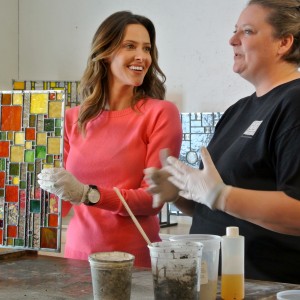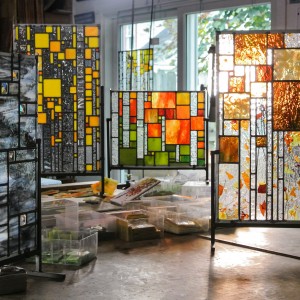
Josephine A. Geiger, Stained Glass
Josephine A. Geiger
When she sets out to create one of her colorful, geometric stained glass “landscape mosaics,” Josephine A. Geiger finds inspiration everywhere, some sources, to the average eye, may even seem boring. Geiger can look at a photo or other image, and see it as it might look in stained glass. Though her work can be labeled “abstract,” Geiger crafts each piece from traditional leaded stained glass and, occasionally, copper.
Have you always worked with your hands?
Oh my, yes. From the time I can remember I was always doing something: playing with modeling clay; making things with scraps of wood, nails and string; pottery (I even worked for a potter when I was in high school) and creating my own clay and glazes; drawing and painting, and dreaming up construction projects to DIY which lead to me getting a professional degree in Architecture (I actually decided to be an architect when I was 12), and worked in the field for about 10 years. Then I took my first stained glass class, and I fell in love for real.
What drew you to your chosen craft?
During that first class (and I’m pretty sure my friend that took it with me never made another panel) I realized that I loved the glass even more than architecture, and I began to dream about making more. At the same time, I was disillusioned with my architectural management job, so I jumped of the proverbial cliff. The studio was born, went through some growing pains for a few years, but then I settled in, developed my style, and started to get my work seen.
 What do you enjoy most about your craft?
What do you enjoy most about your craft?
Easy. It’s the glass. It may seem hard and brittle, but glass has so many facets to it. Transparent and textured. Opaque and colorful. Streaky and solid. And it looks completely different depending upon the light source. If it’s sunny, the glass simply glows with color, bevels shoot rainbows across the room, and the translucent colors bathe the room in color.
I love finding just the right color for just the perfect place in the panel. I’m always thinking about how the sun will hit the window, or if it will be hung on the north side, how the ambient light will affect it, or how it will look at night when the lights are on inside and dark outside. And for commissions, where will it be located? It makes a big difference if the piece will be in someone’s bathroom, bedroom, kitchen or living room, or if the neighbor lives 10 feet or 10 miles. All of this affects what type of glass is used to some extent. And this is where some of my architectural background comes into play. I love solving problems and designing solutions, and being able to design a solution in the form of glass artwork is simply the best of both worlds.
How long did it take you to become an expert?
Ha! I have been working as a glass artisan since 2003, but it’s only been recently that I even feel like I’m an ‘expert’ and that’s only intermittently. Though I have to say it felt good to have a roomful of peers at the Stained Glass Association (SGAA) conference this summer compliment me on my technique and skills. With that said, I definitely have a lot to learn, and even more ideas to explore. I’ve been experimenting with incorporating copper and other metals into my panels, and want to delve deeper into those materials with the glass.
How many hours do you spend making each item?
Lots of people ask, “How long did that take to make?” Well, it may have taken me only a few hours last week, but could I have made it ten years ago? Maybe. Though if I had made it ten years ago, it likely would have taken me days to complete. Pretty much every professional artist hates this question. Because we work on our craft every day, which means we work faster, and with more skill than a hobbyist.
My first ever leaded glass panel took me 6-8 weeks to complete while I was learning during the class. It had 120 pieces in it. Now I could easily make the entire panel in a day, because I know what I’m doing. Does that mean I rush the process, skip steps, or have poor quality? No. In fact that first panel has so many imperfections in it, I have often thought about tearing it apart to fix it! But I won’t because it means something to me.
If you could spend a day with a master of your craft (past or present), who would it be and why?
Robert Oddy. The level of detail and precision in his work is astounding. At the risk of being shot, I think his artwork is better than Tiffany’s, at the very least rivals it. Love how he uses the colors in the glass, layering and manipulating the translucence to create shadows. And the sheer perfection in his designs, layout and lead lines is truly beautiful.
Why is it important for people to make things with their own hands?
So much of our world is being powered with computers. Now kids even learn to draw on a tablet, with a stylus, picking colors from chart. I have to wonder, what would happen if they picked up a pencil? Could they still draw? Probably, but the erasing might get them pretty frustrated, and would they know how to manipulate the pencil to get a thicker line, or thinner, or even graduated shade and shadows? I can pretty much guarantee that they would not know how to mix the colors on a palette, nor the difference between a tint or shade. So yes, it is very important to make things. Beside the satisfaction of saying, “I made this!” it develops an appreciation for the work itself. And the skills needed to do it beyond just “talent.”
In what ways are handmade goods better than those that are mass-produced?
Wow, this is great soapbox question! Most manufactured items started out life being handmade – that’s what a prototype is. The automobile is a prime example: individual cars made, and then manufacturing lines developed to speed up production times and reduce maintenance issues. And in many cases, the manufacturing process eliminates a lot of human errors that could cause problems. BUT, it is that human imperfection that makes the handcrafted works so beautifully unique.
In my artwork, partly because I don’t work from patterns, and partly because of the nature of glass itself, even if I wanted to duplicate a piece, it would never be identical. There is a ton of production in the handcrafted arena: potters throw hundreds of bowls; glass blowers produce entire sets of items; woodworkers assemble blocks of cutting boards; I myself make fused ornaments. But the difference is that even though we are making many pieces of a similar size, shape and color, each of these pieces is still touched by the artisan every step of the way. And no matter how hard you try, some slight variations occur and make each piece slightly unique. And nothing can beat supporting a local artist. I could cite a ton of statistics on how much money stays in the community when goods are bought from local artists, craftsmen and businesses.




 Available on Channel 1420 in the United States
Available on Channel 1420 in the United States  Available in the United States
Available in the United States  Available on Channel 209 in Canada
Available on Channel 209 in Canada  Available in the United States
Available in the United States 
 Available in the United States
Available in the United States  Available in the United States
Available in the United States  Available in the United States
Available in the United States  Available in the United States & Canada
Available in the United States & Canada  Available in the United States
Available in the United States  Available in the United States
Available in the United States  Available on Channel 839 in the United States
Available on Channel 839 in the United States  Available in the United States
Available in the United States 